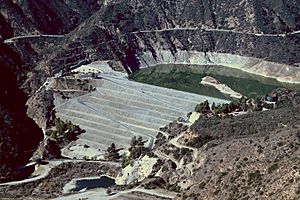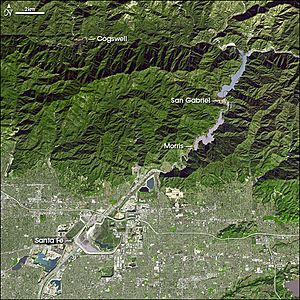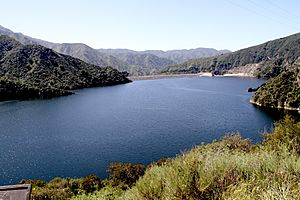San Gabriel Dam facts for kids
Quick facts for kids San Gabriel Dam |
|
|---|---|

The dam seen from Glendora Mountain Road
|
|
| Country | United States |
| Location | Los Angeles County, California |
| Coordinates | 34°12′20″N 117°51′33″W / 34.20556°N 117.85917°W |
| Construction began | 1932 |
| Opening date | 1939 |
| Construction cost | $17 million |
| Owner(s) | Los Angeles County Flood Control District |
| Dam and spillways | |
| Type of dam | Rock-fill |
| Impounds | San Gabriel River |
| Height | 315 ft (96 m) |
| Length | 1,520 ft (460 m) |
| Spillway type | Ungated overflow |
| Reservoir | |
| Creates | San Gabriel Reservoir |
| Total capacity | 44,183 acre⋅ft (54,499 dam3) |
| Catchment area | 205 sq mi (530 km2) |
| Surface area | 525 acres (212 ha) |
| Power station | |
| Operator(s) | City of Azusa |
| Commission date | 1940 |
| Installed capacity | 3 MW |
| Annual generation | 4,464,000 KWh |
The San Gabriel Dam is a large dam built from rocks. It's located on the San Gabriel River in Los Angeles County, California. You can find it inside the Angeles National Forest. The dam was finished in 1939.
This dam holds back the main part of the San Gabriel River. It's about 2.5 miles (4.0 km) downstream from where the river's East and West Forks meet. These forks collect water from a big part of the San Gabriel Mountains. The San Gabriel Dam is just upstream from the Morris Dam.
The dam helps control floods, adds water to the ground (called groundwater recharge), and makes electricity. These are all very important for the many people living in the San Gabriel Valley and the larger Greater Los Angeles area.
Contents
Building the San Gabriel Dam
In the 1920s, a group called the Los Angeles County Flood Control District wanted to build a huge dam. This dam would be on the San Gabriel River, just below where its East and West forks join. It was planned to be 512-foot (156 m) tall and 2,500-foot (760 m) long. The idea was to stop floods and save water.
This project was first called the San Gabriel Forks Dam. But it was stopped in 1929. There were problems at the building site, including a big landslide. Experts looked into it and said the dam couldn't be built safely.
Two Dams Instead of One
Because of these issues, the plan changed. Instead of one giant dam, they decided to build two smaller ones. These were San Gabriel No. 1 (which became the San Gabriel Dam) and San Gabriel No. 2 (which became Cogswell Dam). San Gabriel No. 1 was built about 2 miles (3.2 km) below the original site. San Gabriel No. 2 was built on the West Fork, about 15 miles (24 km) upstream from where the forks meet.
Building San Gabriel No. 1 was supposed to be cheaper than it turned out to be. This caused some problems, especially during the Great Depression. People were worried about wasting money. A vote to get money for the project failed by a small amount. So, the city asked the federal government's Public Works Administration for help to finish the project.
Construction and Design
The San Gabriel No. 1 dam was designed to be a "rock-fill" dam. This type of dam is very strong and stable, especially in areas where earthquakes might happen. Construction on the 315-foot (96 m) tall San Gabriel Dam began in 1932. It was finally completed in 1939.
The 1938 Flood Test
In early 1938, before the dam was fully finished, Southern California had huge floods. The heaviest rain fell in the San Gabriel Mountains, making the San Gabriel River swell. On March 2-3, 1938, a massive flood of 150,000 cu ft/s (4,200 m3/s) rushed out of the mountains into the San Gabriel Reservoir.
Even though it wasn't complete, the San Gabriel Dam helped a lot. It reduced the flood's peak flow by about 40,000 cu ft/s (1,100 m3/s). Further downstream, Morris Reservoir also absorbed about 30,000 cu ft/s (850 m3/s). Together, these dams cut the flood's strength by more than half.
How the Dam Manages Water
The water stored behind the San Gabriel Dam is very important for groundwater recharge. This means the water slowly soaks into the ground, refilling underground water supplies. This is especially important during the dry season, which runs from April to October.
Water from San Gabriel, Cogswell, and Morris Dams is slowly released during these dry months. It flows to special areas called "spreading grounds" in San Gabriel Canyon (Azusa) and Peck Basin (near Arcadia). There, the water seeps into the local groundwater basin.
The San Gabriel Reservoir
The large lake behind the dam is called San Gabriel Reservoir No. 1. When it's full, it's almost 3 miles (4.8 km) long. The reservoir covers 525-acre (212 ha) and can hold 44,183 acre⋅ft (54,499,000 m3) of water. This makes it one of the biggest reservoirs in Southern California that's built directly on a river.
Over time, the reservoir's capacity has shrunk. When the dam was first built, it could hold 53,344 acre⋅ft (65,799,000 m3). But dirt and sand (called sedimentation) have built up, reducing the amount of water it can hold by 17%.
Removing Sediment
People started thinking about removing this built-up sediment in the 1980s. This was after several big wildfires in the San Gabriel Mountains. These fires were followed by floods that washed millions of cubic yards of sediment into the reservoir.
In 2004, the reservoir was emptied to allow for sediment removal. However, heavy rains in the winter of 2004–2005 refilled the reservoir, delaying the work.
Deciding where to put the removed sediment has been a challenge. A project in 2005 stored about 6,100,000 cubic yards (4,700,000 m3) of sediment in a nearby canyon. But this is no longer allowed due to environmental and safety concerns. Another idea was to truck the sediment to local beaches to help rebuild them, but this was also stopped. Now, most of the sediment is sold for building materials or goes to landfills, but these options are limited.
Working with Other Dams
The San Gabriel Dam works with other dams to control floods. These include Morris and Cogswell Dams in the mountains, and Santa Fe and Whittier Narrows Dams on the lower San Gabriel River. They all work together to manage water flow.
Making Electricity at the Dam
The San Gabriel Dam has two small power plants that make electricity. They can produce a maximum of 4.95 megawatts (MW) of power. These plants are owned by the Department of Public Works.
Water from the reservoir can be sent through a tunnel called the Azusa Conduit. This tunnel leads to another power plant located downstream from Morris Dam. The main power plant is on the south side of the San Gabriel River, right below the entrance to San Gabriel Canyon.
The first power plant here was built way back in 1898. It was owned by the San Gabriel Electric Company. For its first few decades, it powered electric train lines in Los Angeles. At that time, this plant used water directly from the San Gabriel River.
In 1917, the plant was sold to Southern California Edison. Later, it became part of Pasadena's city electric system. When the San Gabriel Dam was finished in 1939, it provided a more steady water supply for the power plant. In the late 1940s, a new, more powerful facility was built to replace the old one. This new plant could produce 3,000 kilowatts (KW) of electricity.
Fun Fact
The San Gabriel Dam appeared in the 2001 action movie Behind Enemy Lines. In the movie, it was shown as being in southern Bosnia.



